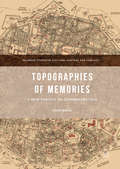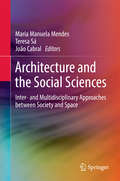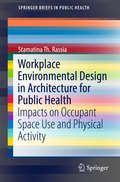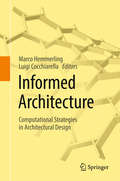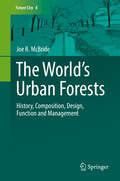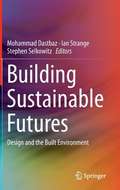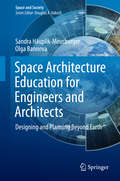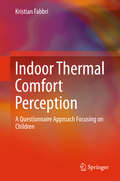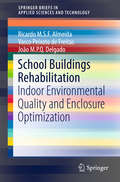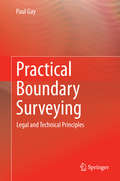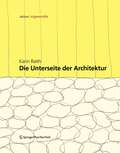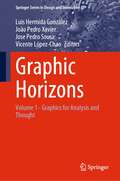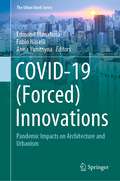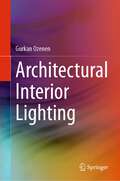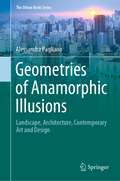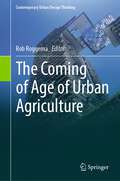- Table View
- List View
Topographies of Memories: A New Poetics of Commemoration
by Anita BakshiThis book explores new approaches towards developing memorial and heritage sites, moving beyond the critique of existing practices that have been the traditional focus of studies of commemoration. Offering understandings of the effects of conflict on memories of place, as manifested in everyday lives and official histories, it explores the formation of urban identities and constructed images of the city. Topographies of Memories suggests interdisciplinary approaches for creating commemorative sites with shared stakes. The first part of the book focuses on memory dynamics, the second on Nicosia, the divided capital of Cyprus, and the third on physical and material world interventions. Design practices and modes of engagement with places of memory are explored, making connections between theoretical explorations of memory and forgetting and practical strategies for designers and practitioners.
Topographies of Memories: A New Poetics of Commemoration
by Anita BakshiThis book explores new approaches towards developing memorial and heritage sites, moving beyond the critique of existing practices that have been the traditional focus of studies of commemoration. Offering understandings of the effects of conflict on memories of place, as manifested in everyday lives and official histories, it explores the formation of urban identities and constructed images of the city. Topographies of Memories suggests interdisciplinary approaches for creating commemorative sites with shared stakes. The first part of the book focuses on memory dynamics, the second on Nicosia, the divided capital of Cyprus, and the third on physical and material world interventions. Design practices and modes of engagement with places of memory are explored, making connections between theoretical explorations of memory and forgetting and practical strategies for designers and practitioners.
Architecture and the Social Sciences: Inter- and Multidisciplinary Approaches between Society and Space
by Maria Manuela Mendes Teresa Sá João CabralThis book contributes to current debates on the relationship between architecture and the social sciences, highlighting current interdisciplinary and transdisciplinary teaching as well as research and practice in architecture and urbanism. It also raises awareness about the complementarities and tensions between the spaces of the project, including the construction spaces and living space. It gives voice to recent projects and socio-territorial interventions, focusing on interdisciplinary and multidisciplinary approaches between society and space. Divided into two parts, the first part discusses the possible dialogue between social sciences and architecture, while the second part explores architecture, politics and social change in urban territories from a European perspective.
Workplace Environmental Design in Architecture for Public Health: Impacts on Occupant Space Use and Physical Activity (SpringerBriefs in Public Health)
by Stamatina Th. RassiaThis concise volume analyzes the potential for the workplace environment—where so many people spend so much of their day—to improve workers’ capacity for health and wellness. It pinpoints the link between sedentary lifestyles and poor health, and explores the role of office spatial design in encouraging physical activity to promote physical activity, health and prevent disease. The featured research study tracks workers’ movement in a variety of office layouts, addressing possible ways movement-friendly design can co-exist with wireless communication, paperless offices, and new corporate concepts of productivity. From these findings, the author’s conclusions extend public health concepts to recognize that influencing population-wide levels of activity through office architectural design alone may be possible. This SpringerBrief is comprised of chapters on : Physical activity and disease: Theory and practice Space-use and the history of the office building Identifying factors of the office architectural design that influence movement, Interdisciplinary research methods in studying worker physical activity, decision-making and office design characteristics The KINESIS model for simulating physical activity in office environmentsThe questions and potential for solutions in Workplace Environmental Design in Architecture for Public Health will interest and inform researchers in interdisciplinary topics of public health and architecture as well as graduate and post-graduate students, architects, economists, managers, businesses as well as health-conscious readers.
Informed Architecture: Computational Strategies in Architectural Design
by Marco Hemmerling Luigi CocchiarellaThis book connects the different topics and professions involved in information technology approaches to architectural design, ranging from computer-aided design, building information modeling and programming to simulation, digital representation, augmented and virtual reality, digital fabrication and physical computation. The contributions include experts’ academic and practical experiences and findings in research and advanced applications, covering the fields of architecture, engineering, design and mathematics. What are the conditions, constraints and opportunities of this digital revolution for architecture? How do processes change and influence the result? What does it mean for the collaboration and roles of the partners involved. And last but not least: how does academia reflect and shape this development and what does the future hold? Following the sequence of architectural production - from design to fabrication and construction up to the operation of buildings - the book discusses the impact of computational methods and technologies and its consequences for the education of future architects and designers. It offers detailed insights into the processes involved and considers them in the context of our technical, historical, social and cultural environment. Intended mainly for academic researchers, the book is also of interest to master’s level students.
The World’s Urban Forests: History, Composition, Design, Function and Management (Future City #8)
by Joe R. McBrideThe purpose of this book is to examine urban forests in cities around the world. It will ask questions about the history, composition, structure, and management of trees in urban areas. Data for this book was collected in 33 cities across broad geographical areas known as biomes. Constraints and opportunities imposed on urban forest composition, design, and management by the ecological characteristics of these biomes will be examined. The book will also address the cultural and historical factors that influenced the characteristics of urban forests around the world.
Building Sustainable Futures: Design and the Built Environment
by Mohammad Dastbaz Jon Price Ian Strange Stephen SelkowitzThis book presents state-of-the-art research and case studies on new approaches to the design, construction and planning of our cities. Emphasis is placed on the role of alternative and renewable energy in the development of urban infrastructures that enable sustainable futures. Reflecting the multi-faceted efforts required to successfully meet sustainability challenges, this book is a collaboration between practitioners and academics across a broad spectrum of specializations. Compelling research findings are explained in the context of practical implementation, enhanced by case studies from industry leaders in order to create a pragmatic reference across policy areas where environmentally aware decision making is required.
Building Sustainable Futures: Design and the Built Environment (PDF)
by Mohammad Dastbaz Jon Price Ian Strange Stephen SelkowitzThis book presents state-of-the-art research and case studies on new approaches to the design, construction and planning of our cities. Emphasis is placed on the role of alternative and renewable energy in the development of urban infrastructures that enable sustainable futures. Reflecting the multi-faceted efforts required to successfully meet sustainability challenges, this book is a collaboration between practitioners and academics across a broad spectrum of specializations. Compelling research findings are explained in the context of practical implementation, enhanced by case studies from industry leaders in order to create a pragmatic reference across policy areas where environmentally aware decision making is required.
Space Architecture Education for Engineers and Architects: Designing and Planning Beyond Earth (Space and Society)
by Sandra Häuplik-Meusburger Olga BannovaThis book considers two key educational tools for future generations of professionals with a space architecture background in the 21st century: (1) introducing the discipline of space architecture into the space system engineering curricula; and (2) developing space architecture as a distinct, complete training curriculum. Professionals educated this way will help shift focus from solely engineering-driven transportation systems and “sortie” missions towards permanent off-world human presence. The architectural training teaches young professionals to operate at all scales from the “overall picture” down to the smallest details, to provide directive intention–not just analysis–to design opportunities, to address the relationship between human behavior and the built environment, and to interact with many diverse fields and disciplines throughout the project lifecycle. This book will benefit individuals and organizations responsible for planning transportation and habitat systems in space, while also providing detailed information on work and design processes for architects and engineers.
Indoor Thermal Comfort Perception: A Questionnaire Approach Focusing on Children (SpringerBriefs in Applied Sciences and Technology)
by Kristian FabbriProviding a methodology for evaluating indoor thermal comfort with a focus on children, this book presents an in-depth examination of children’s perceptions of comfort. Divided into two sections, it first presents a history of thermal comfort, the human body and environmental parameters, common thermal comfort indexes, and guidelines for creating questionnaires to assess children’s perceptions of indoor thermal comfort. It then describes their understanding of the concepts of comfort and energy, and the factors that influence that perception. In this context, it takes into account the psychological and pedagogical aspects of thermal comfort judgment, as well as architectural and environmental characteristics and equips readers with the knowledge needed to effectively investigate children’s perspectives on environmental ergonomics.The research field of indoor thermal comfort adopts, on the one hand, physical parameter measurements and comfort indexes (e.g. Predicted Mean Vote (PMV) or adaptive comfort), and on the other, an ergonomic assessment in the form of questionnaires. However the latter can offer only limited insights into the issue of comfort, as children often use different terms than adults to convey their experience of thermal comfort. The books aims to address this lack of understanding with regard to children’s perceptions of indoor thermal comfort.The book is intended for HVAC engineers and researchers, architects and researchers interested in thermal comfort and the built environment. It also provides a useful resource for environmental psychologists, medical and cognitive researchers.
Interior Design: Conceptual Basis
by Anthony SullyMaximizing reader insights into interior design as a conceptual way of thinking, which is about ideas and how they are formulated. The major themes of this book are the seven concepts of planning, circulation, 3D, construction, materials, colour and lighting, which covers the entire spectrum of a designer’s activity. Analysing design concepts from the view of the range of possibilities that the designer can examine and eventually decide by choice and conclusive belief the appropriate course of action to take in forming that particular concept, the formation and implementation of these concepts is taken in this book to aid the designer in his/her professional task of completing a design proposal to the client. The purpose of this book is to prepare designers to focus on each concept independently as much as possible, whilst acknowledging relative connections without unwarranted influences unfairly dictating a conceptual bias, and is about that part of the design process called conceptual analysis. It is assumed that the site, location, building and orientation, as well as the client’s brief of activities and needs have been digested and analysed to provide the data upon which the design process can begin. Designed as a highly visual illustrative book, as the interior design medium demands, the hands-on creative process of designing is detailed with original drawn illustrations. Concentrating on the conceptual process of designing interiors, and defining what these concepts are, this book will help the designer to organise his/her process of designing and to sharpen the links between the various skill bases necessary to do the job. This book will be stimulating for students and instructors alike and is aimed at any student who maybe majoring in interior design, interior architecture, architecture, design thinking or furniture design. It could also be a useful reference for students of design management and design leadership.
School Buildings Rehabilitation: Indoor Environmental Quality and Enclosure Optimization (SpringerBriefs in Applied Sciences and Technology)
by Ricardo M.S.F. Almeida Vasco Peixoto de Freitas João M.P.Q. DelgadoThis book discusses the effect of different school building rehabilitation strategies on the classrooms’ indoor environmental quality (IEQ) and presents a multi-objective methodology for school building enclosure optimization combining artificial neural networks and lifecycle costs. The special features of this book are that it (a) presents the state-of-the-art in school building rehabilitation, (b) covers the IEQ assessment of several school buildings, including non-rehabilitated and rehabilitated according to different strategies; and (c) proposes a multi-objective optimization procedure.The rehabilitation of a school building should be regarded as a procedure combining a number of (sometimes conflicting) variables and objectives, including energy, IEQ and costs (initial, operational and maintenance), in the search for an “optimum solution.” The main benefit of the book is that it discusses the main topics related to school building rehabilitation, presents results of the IEQ assessment on 9 school buildings and launches a discussion on how the “in-use” performance of schools is key to understanding how designed performance is actually experienced. It maps the most commonly used multi-objective algorithms and artificial neural network architectures and proposes a methodology for combining these numerical tools with dynamic building simulations and lifecycle cost analysis to optimize school building enclosures. This methodology will be of value to scientists and engineers alike, while also addressing a variety of related disciplines, such as civil and mechanical engineering, architecture and mathematics.
Green Roof Ecosystems (Ecological Studies #223)
by Richard K. SuttonThis book provides an up-to-date coverage of green (vegetated) roof research, design, and management from an ecosystem perspective. It reviews, explains, and poses questions about monitoring, substrate, living components and the abiotic, biotic and cultural aspects connecting green roofs to the fields of community, landscape and urban ecology. The work contains examples of green roof venues that demonstrate the focus, level of detail, and techniques needed to understand the structure, function, and impact of these novel ecosystems. Representing a seminal compilation of research and technical knowledge about green roof ecology and how functional attributes can be enhanced, it delves to explore the next wave of evolution in green technology and defines potential paths for technological advancement and research.
Eco-Landscape Design
by John A. Flannery Karen M. SmithThe ability to adapt to a changing environment has ensured the continued survival of the human race into the 21st century. The challenges to be faced in this century are now well documented by the United Nations Intergovernmental Panel on Climate Change. The effects of drought, melting polar ice and increased incidences of extreme weather events will impact on the diverse landscapes of the earth and a human population predicted to be 9 billion by the middle of the 21st century, a three-fold increase in less than one hundred years.This book provides a valuable insight into landscaping activity worldwide by those tasked with housing, feeding and nurturing all species that share the planet. Research for this publication reveals the growth of non-anthropized design philosophies, acknowledging that humanity cannot be indefinitely sustained if animal, bird and plant life are excluded. The precious resources of water and the air that we breathe are no longer taken for granted; rivers flowing through the world’s mega-cities are now being cleaned, restored and given pride of place in the landscapes they flow through. Conservation projects provide evidence that even fragile island and desert landscapes can be protected from the negative impacts of population. Eco-Landscape Design demonstrates that an intelligent and thoughtful approach to landscape design can not only ensure survival, it can reap compound benefits and rewards far in excess of those originally envisaged.
Practical Boundary Surveying: Legal and Technical Principles
by Paul GayThis complete guide to boundary surveying provides landowners, land surveyors and students with the necessary foundation to understand boundary surveying techniques and the common legal issues that govern boundary establishment. Far from a simple engineering function, boundary establishment is often a difficult and delicate matter, with real monetary and legal ramifications if not accomplished accurately. This book helps readers to understand why such challenges exist and what remedies may be available. Using only simple and logically explained mathematics, the principles and practice of boundary surveying are demystified for those without prior experience and the focused coverage of pivotal issues such as easements and setting lot corners will aid even licensed practitioners in untangling thorny cases. Practical advice on using both basic and advanced instruments is included, alongside clear explanations of legal regulations that will impact any surveyor’s work. For those who desire a more in-depth treatment of the mathematical aspects of boundary surveying, the Appendix includes the underlying theory and many examples of typical calculations performed by boundary surveyors.
Human Migration to Space: Alternative Technological Approaches for Long-Term Adaptation to Extraterrestrial Environments (Springer Theses)
by Elizabeth Song LockardHuman migration to space will be the most profound catalyst for evolution in the history of humankind, yet this has had little impact on determining our strategies for this next phase of exploration. Habitation in space will require extensive technological interfaces between humans and their alien surroundings and how they are deployed will critically inform the processes of adaptation. As humans begin to spend longer durations in space—eventually establishing permanent outposts on other planets—the scope of technological design considerations must expand beyond the meager requirements for survival to include issues not only of comfort and well‐being, but also of engagement and negotiation with the new planetary environment that will be crucial to our longevity beyond Earth. Approaching this question from an interdisciplinary approach, this dissertation explores how the impact of interior space architecture can meet both the physical and psychological needs of future space colonists and set the stage for humankind to thrive and grow while setting down new roots beyond Earth.
Die Unterseite der Architektur: Konzepte und Konstruktionen an der Schnittstelle zwischen Kultur und Natur (Edition Angewandte)
by Karin RaithThema und Fragestellungen Dieses Buch handelt von der Beziehung zwischen Bauwerk und Boden. Der Ausgangspunkt der Untersuchung war die Beobachtung, dass Gebäude auf verschiedene Weise auf dem Baugrund ruhen, in ihn eingegraben sind, ihn durchdringen, sich über ihn erheben oder sich von ihm loslösen. Diese unt- schiedlichen Reaktionen auf den Baugrund manifestieren sich auf verschiedenen Maßstabsebenen, sowohl bei der Wahl und architektonischen Interpretation des Standortes eines Gebäudes und in der Ausformung des Baukörpers als auch im konstruk- ven und gestalterischen Detail. Die Architektur wird durch ihre räumlich-volumetrische Form in die geomorphologische Struktur der Landschaft eingeschrieben. Sie kann als eine Anpassung, Ergänzung oder eine Überhöhung, aber auch als Widerpart und Negation des Terrains in Erscheinung treten. Die Architektur tritt über einzelne spezialisierte Elemente mit dem Boden in direkte Verbindung: mit Fundamenten, Sockeln und Stützen, mit Kellergeschoßen, dem Unterbeton, mit Rollierungen, Abdichtungen und Dämmungen. Einige der Bauteile, die dafür verantwortlich sind, die Lasten vom Gebäude auf den Baugrund zu übertragen und Feuchtigkeit und Kälte von seinem Inneren fernzuhalten, erfüllen ihre Aufgaben still und verlässlich in der Tiefe des Baugrundes. Sie sind, sobald der Bauvorgang abgeschlossen ist, nicht mehr zu sehen. Sie haben konstruktiv einiges zu leisten, darüber hinaus aber nichts mitzuteilen oder darzustellen. Viel interessanter sind hingegen die Bauteile in der Zone, wo Architektur und Erdoberfläche sichtbar aufeinandertreffen. Der spannendste Topos der Konfrontation von Bau und Boden 11 sind die reale oder imaginäre Schnittlinie der Gebäudeoberfläche mit dem Gelände und das Kraftfeld, das diese Linieumgibt.
Öffentliche Kunst, Kunst im öffentlichen Raum Niederösterreich, Band 8: / Public Art Lower Austria, Volume 8 (Veröffentlichte Kunst. Kunst im öffentlichen Raum Niederösterreich Public Art Lower Austria #8)
Kunst im öffentlichen Raum in Niederösterreich ist ein einzigartiges Modell, das international höchste Anerkennung findet. Die im ländlichen und kleinstädtischen Raum entstandenen Projekte bedeutender, aber auch junger unbekannter KünstlerInnen setzen sich mit der Landschaft, der Kulturgeschichte und der Architektur auseinander oder entstanden auf der Basis von sozialer und wissenschaftlicher Recherche. Der vorliegende Band dokumentiert die Projekte der Jahre 2004 – 2006. Neben der Projektdokumentation äußern sich Experten unterschiedlichster Bereiche in einer kunstwissenschaftlichen und theoretischen Diskussion zur "Gestaltung von Kreisverkehren", ein Thema brisanter Aktualität in der Gestaltung von Landschaft und Umgebung.
GAM.02 - Design Science in Architecture: Graz Architektur Magazin / Graz Architecture Magazine (Graz Architektur Magazin Graz Architecture Magazine #2)
by Fakultät Der Architektur Der Technischen Graz S. Baumann-Cox M. Nievoll U. Hirschberg G. Koberg J. Köppler R. Riewe U. SchwarzGAM 02 ist dem Thema "Design Science in Architecture" gewidmet. Forschung und Wissenschaftlichkeit in der Architektur werden beleuchtet und hinterfragt. Der Ansatz versteht sich interdisziplinär und integriert kulturelle, räumliche, technische und informationswissenschaftliche Aspekte. "Design Science ist die effiziente Anwendung von wissenschaftlichen Prinzipien zur bewussten Gestaltung unseres gesamten Umfeldes." (Buckminster Fuller)
Smart Cities: Innovations, Challenges and Future Perspectives (S.M.A.R.T. Environments)
by Leonidas G. Anthopoulos Sushobhan Majumdar Vinay KandpalThis book aims to integrate new technologies and adaptation tools into the process of smart city planning. It also emphasizes the value and importance of modern technologies such as IoT and data science as a smart technology for the formation of a smart city. The authors believe that various technologies in a smart city will reduce all the problems for the sustainable growth and future prospects of the city. The first section of this book discusses the innovation of new technologies (AI, data science, block chain, etc.) that has flourished in recent decades which will make the city smarter. This section also describes that block chain and IoT (Internet of Things) are two transformative technologies that can greatly impact smart cities by enhancing security, improving transparency, and enabling efficient management of resources. The second section of the book explains about the uses of AI tools and smart technologies (like waste management, public safety and security) for the development and management of smart cities. This chapter also describes AI-powered systems that are integrated into smart buildings to optimize energy usage, enhance occupant comfort, and improve building management. These systems can adjust lighting and HVAC settings based on occupancy, learn user preferences, and provide personalized energy efficiency recommendations. The third portion of the book investigates the recent challenges and barriers of smart city that have been faced by the smart cities in the recent decades. This section also describes various challenges and barriers for the implementation of IoT sensor, AI technologies, etc., for the formation of a smart city. The future prospects of a smart city are the main theme of the last chapter. In this section, an attempt has been made about the future vision and outlook of the smart city. This chapter also describes different approaches (like smart grid, societal smart city, smart city model, etc.) for the future planning and management of the city.
Graphic Horizons: Volume 1 - Graphics for Analysis and Thought (Springer Series in Design and Innovation #42)
by Luis Hermida González João Pedro Xavier Jose Pedro Sousa Vicente López-ChaoThis book reports on several advances in architectural graphics, with a special emphasis on education, training, and research. It gathers a selection of contributions to the 20th International Congress of Architectural Graphic Expression, EGA 2024, held on May 27-29, 2024, in Porto, Portugal, with the motto: "Graphic Horizons". This is the first of a 3-volume set.
COVID-19: Pandemic Impacts on Architecture and Urbanism (The Urban Book Series)
by Anna Yunitsyna Edmond Manahasa Fabio NaselliThis book gives an overview of the shifting paradigm from traditional design techniques and standards to new values and methods that occurred in response to confronting the COVID-19 pandemic. The theoretical studies of the phenomenon of "new normality" in architecture, urbanism and social sciences are a source of knowledge for researchers, professors and students in the fields of architecture, urbanism and interior design. On-site applications of post-COVID-19 structures will be interesting for students, practitioners, developers and city managers. The issue of online design teaching and learning provides a set of practices that can be applied by both educators and trainees. The book also is useful for readers who are interested in recent trends in architecture and interior design: it provides a deep analysis of recent changes in architecture, which aim to make the environment disease-free and the space habitable during the long periods of lockdown.
Architectural Interior Lighting
by Gurkan OzenenArchitectural Interior Lighting is an essential guide to creating well-lit, visually appealing interior spaces. The book begins with an overview of light and color theory, lighting fundamentals, and design principles. It then covers artificial, natural, decorative, and professional lighting in interior design, as well as standards and regulations, controls and systems, sustainable lighting, energy efficiency, light pollution reduction, and the use of environmentally friendly materials. With a focus on practical applications and real-world examples, this book provides readers with the tools and knowledge necessary to achieve their design goals while considering the latest trends and techniques in the field. A valuable resource for professionals and students in architecture and lighting design, it will also appeal to anyone interested in creating visually stunning and functional interior spaces.
Geometries of Anamorphic Illusions: Landscape, Architecture, Contemporary Art and Design (The Urban Book Series)
by Alessandra PaglianoThis book intends to focus exclusively on anamorphic experiments in contemporary art and design, leaving an in-depth historical examination of its Baroque season to other studies. Themes, languages and fields of application of anamorphosis in contemporary culture are critically analyzed to make the reader aware of the communicative potentiality of this kind of geometrical technique. The book also has the aim to teach the reader the most appropriate geometric techniques for each of them, in order to achieve the designed illusion. Each typology of anamorphosis is accompanied in this book by contemporary installations, a geometrical explanation by means of 3D models and didactic experiments carried on in collaboration with the students of the Department of Architecture in Naples.
The Coming of Age of Urban Agriculture (Contemporary Urban Design Thinking)
by Rob RoggemaFor a long time, urban agriculture initiatives have been explored and novel policy and planning practices have been investigated. With the global food crisis the role urban agriculture has to play becomes more and more urgent. The potentials are large: it brings social justice, it limits climate change, it provides a healthy urban condition, it stimulates biodiversity and gives disadvantaged people an economic opportunity. After 15 years in the making, the time is ripe to see whether the growing of food has established a prominent position in urban planning and policies, food productivity, safety and security, social well-being, the arts, and human health. In this volume several aspects of growing food in the city are explored. Urban Agriculture plays a significant role in society. Nevertheless, it did not become a mainstream topic in day-to-day practice. This book provides concrete solutions and clues how to give urban food production a crucial role in the future planning of urban environments.
